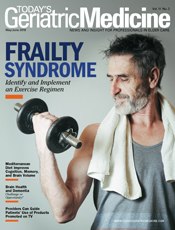
May/June 2018
Innovations in Geriatrics: Wearables Gain Traction in Elder Population Wearables have proven to be popular among consumers and are steadily expanding into new industries, including health care. In fact, in 2017, Gartner, a leading worldwide research and advisory company, forecast that more than 310 million wearable devices would be sold worldwide, an almost 17% increase over the number sold in 2016. However, it's also been proven that one-third of wearables users abandon them, leaving them on the bureau or in a drawer within six months of purchase, according to MobiHealthNews. This lack of long-term use reveals the importance of finding solutions that predominate in the sea of wearables—one that people will want to continue to use and in which they'll find value for years to come. We find ourselves at a critical point in health care where wearables will either slowly fade away or evolve to bring further value. While companies are developing game-changing devices for various populations, one of the most critical populations to examine is older adults, who look to age well and in place. Supporting Aging in Place In addition to helping elders remain safe, medical alert pendants provide tremendous peace of mind for caregivers. While caregivers are focused on keeping their loved ones healthy, their caregiving role requires an inordinate amount of time and resources. Wearables can help reassure caregivers that loved ones are safe and in good hands, whether they live down the street or across the country, enabling them to spend less time worrying and invest more energy in spending quality time with the older adult. Current State and Use of Wearables Through tiny cell phone technology, along with GPS and accelerometer technology, elders no longer need to be tied to their homes to be monitored. As older adults venture outside of their homes, wearables not only help protect them but also collect various kinds of significant health data, such as tracking vital signs or the occurrence of a fall. With the introduction of real-time personalized data, health care has access to actionable insights from end users to provide timely interventions and help provide preventive care. Additionally, wearables for older adults are now used in many skilled nursing and long term care facilities. With the advances in new integrated capabilities, such as remote monitoring and trends analytics, these innovative wearables are transforming elder care. Wearables help senior living facilities proactively monitor resident activity and collect residents' biometric information over time, rather than responding reactively. Also, the fall detection technology incorporated in older adult wearables is becoming crucial, as facilities aren't always able to continually monitor whether residents are walking around and possibly putting themselves at increased risk of falls, particularly those with chronic conditions who are at higher risk of falling. Many senior living facilities are also beginning to shift from using proprietary wireless devices to leveraging Wi-Fi technology that drives secure and reliable connectivity throughout their communities, which allows more technological devices to interoperate. With multiple devices on a single network, data can be compiled in one back-end infrastructure, which ultimately enables facilities to have a more in-depth view of their residents at all times. The Future of Wearables By tailoring the design and applications of this technology for the needs of older adults, their caregivers, and providers, value can be extended in both the hospital and home settings. However, to achieve this, future older adult wearables need incorporate the following: • Focus on the caregiver. While an older adult may not see the value in an app for a wearable, the data generated from the device may help a family member monitor for abnormal patterns and identify a health issue before it escalates. • Dedicated form factors. For experiences such as emergency services and fall detection, devices need to be designed purposefully for the intended user. Accurate biometric sensors or positioning on the body, for example, serve purposes for elders that are different from athletes. • Use data on a need-to-know basis. Wearables for elders will be designed to identify pattern changes so families and care teams can react accordingly. Predictive analytics and smart algorithms will evaluate these patterns, and devices will determine specific actionable moments for care teams and caregivers to intervene as needed. As the wearables market matures, applications specific to elder care will continue to evolve and address each user's needs as well as the needs of provider and caregivers. Advancing Population Health Management As we move away from a fee-for-service health care system, targeting the populations that tend to be the most costly and the highest utilizers of care will be critical. Wearables can play an important role in this move away from episodic care in an expensive emergency department setting to more holistic value-based care, offering health systems the insights needed to focus their efforts on at-risk populations—whether it's an elder at risk of a fall or a patient with a chronic disease who's not taking medications as scheduled. While older adults are adopting this technology, their acceptance remains limited despite the benefits that can be reaped in areas such as medication management and personal response solutions. However, 76% of those aged 65 and older in the United States agreed that connected care technology is important for improving home health care services, according to the Future Health Index study. As this age group shifts from a generation that grew up offline to more tech-savvy aging baby boomers, more older adults and their caregivers will seek digitally connected lives, and physicians will want to harness personal data for preventive care, meaning wearables and other elder technology will have an increased opportunity to play an even larger role in aging for all players involved. — Ripley Martin, MBA, general manager for Philips Lifeline, leads the company's product suite of personal emergency response services and solutions, medication management solutions, and health solutions to support older adults in assisted and senior living facilities. |
